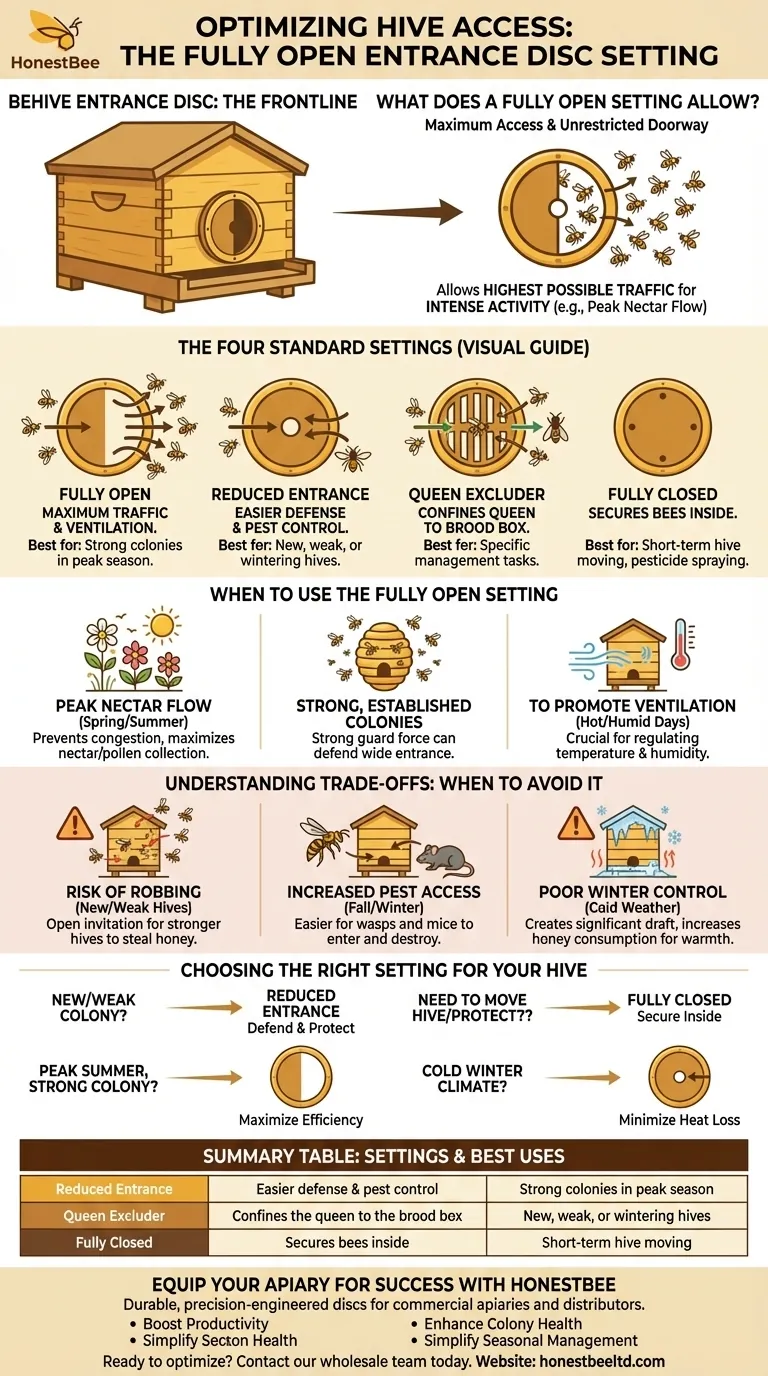A fully open setting on a beehive entrance disc provides maximum access. It creates an unrestricted, wide-open doorway that allows the highest possible traffic of bees to enter and exit the colony. This setting is designed for periods of intense activity.
The entrance disc is more than just a door; it is a critical management tool. The setting you choose directly impacts the colony's defense, ventilation, and foraging efficiency, and the correct choice changes with the seasons and the strength of your hive.

The Purpose of an Entrance Disc
A round entrance disc is a simple, rotating gate that gives you control over the hive's main point of access. It allows a beekeeper to adapt the hive to changing conditions.
More Than Just a Door
Think of the entrance as the hive's frontline. The size of the opening determines how easily bees can come and go, but also how much effort they must expend to defend their home from threats.
The Four Standard Settings
Most entrance discs feature four distinct settings, each serving a specific purpose.
- Fully Open: The largest opening, designed for maximum bee traffic. It prevents congestion during peak foraging periods.
- Reduced Entrance: A much smaller hole that limits access. This makes it easier for a small number of guard bees to defend the hive.
- Queen Excluder: A series of small slots or holes. These are large enough for worker bees to pass through but too small for the larger queen (and drones) to exit.
- Fully Closed: This setting completely blocks the entrance, trapping the bees inside. It is used for specific, short-term situations like moving a hive.
When to Use the Fully Open Setting
Using the fully open setting is ideal when the benefits of high traffic and ventilation outweigh the defensive risks.
During Peak Nectar Flow
In spring and summer, a strong colony has tens of thousands of foragers working constantly. An open entrance prevents a "traffic jam" of bees, maximizing the amount of nectar and pollen they can bring back.
For Strong, Established Colonies
A large, populous hive has a strong force of guard bees. They can effectively monitor and defend a wide entrance against robbing bees from other hives or pests like wasps.
To Promote Ventilation
On hot and humid days, a wide opening is crucial for air circulation. This allows the bees to more easily regulate the internal temperature and humidity, which is vital for raising brood and curing honey.
Understanding the Trade-offs: When to Avoid the Fully Open Setting
A wide-open entrance can be a significant liability for a hive that is not at peak strength.
The Risk of Robbing
For a new, small, or weak colony, a large entrance is an open invitation to disaster. Stronger hives in the area may discover this weak defense and invade to steal the hive's honey stores, a behavior known as "robbing."
Increased Pest Access
A large opening makes it easier for pests to gain entry. While bees can handle wasps, a wide opening in the fall or winter can allow mice to enter and build a nest, destroying comb and consuming honey.
Poor Winter Temperature Control
During cold weather, bees form a tight cluster to generate heat. A large entrance creates a significant draft, forcing the bees to consume more of their precious honey stores just to stay warm.
Choosing the Right Setting for Your Hive
Selecting the correct entrance setting is a fundamental aspect of seasonal hive management.
- If you have a new or weak colony: Use the reduced entrance setting to make defense easier and protect it from robbing.
- If you are in peak summer with a strong, healthy colony: Use the fully open setting to maximize foraging efficiency and ventilation.
- If you need to move the hive or protect it from pesticide spraying: Use the fully closed setting for short durations to keep the bees securely inside.
- If your hive is in a cold winter climate: Use the reduced entrance to minimize heat loss and prevent mice from entering.
Properly managing your hive's entrance is a simple yet powerful way to support your colony's health and productivity throughout the seasons.
Summary Table:
| Setting | Purpose | Best For |
|---|---|---|
| Fully Open | Maximum bee traffic & ventilation | Strong colonies in peak season |
| Reduced Entrance | Easier defense & pest control | New, weak, or wintering hives |
| Queen Excluder | Confines the queen to the brood box | Specific management tasks |
| Fully Closed | Secures bees inside | Short-term hive moving |
Equip Your Apiary for Success with HONESTBEE
Proper hive management starts with the right equipment. At HONESTBEE, we supply durable, precision-engineered beehive entrance discs and other essential supplies designed for the demands of commercial apiaries and distributors.
- Boost Productivity: Ensure your foragers have unimpeded access during heavy flows.
- Enhance Colony Health: Manage ventilation and defense with reliable tools.
- Simplify Seasonal Management: Get the robust equipment that supports your operation year-round.
Ready to optimize your hive entrances? Contact our wholesale team today to discuss your needs and discover how HONESTBEE can support your beekeeping success.
Visual Guide

Related Products
- Multi-Functional Rotary Hive Entrance Disc for Beekeeping
- Multi-Functional Sliding Hive Entrance for Beekeeping
- Professional Reversible Beehive Hive Entrance
- Professional Galvanized Hive Strap with Secure Locking Buckle for Beekeeping
- Wooden Bee Hive Frames for Beekeeping and Wholesale
People Also Ask
- What is the purpose of the steel entrance disc? Master Hive Traffic Control & Security
- What are some alternative strategies to using entrance reducers? Empower Your Bees for Natural Hive Defense
- How does entrance configuration vary seasonally for beekeepers? A Guide to Year-Round Hive Health
- What are the applications of the steel entrance disc? A Beekeeper's Guide to Hive Control
- What are the four entrance options provided by the steel entrance disc? Master Hive Traffic & Protection



















